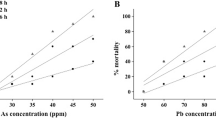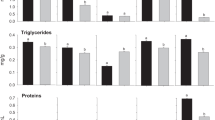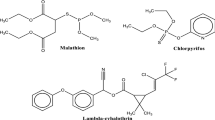Abstract
The acute effect of carbofuran, a carbamate insecticide, was studied on adenosine triphosphatase enzymes in gill, kidney, liver and muscle tissues of a food fish, Clarias batrachus. Glycogen and glycogen phosphorylase were investigated in gill and kidney only. Thirty-six fish were exposed to sublethal concentration (7.6 mg/L) for 6 days. After 6 days, 18 fish were released into freshwater in order to study the recovery response. Eighteen fish were kept in clean water as control. Tissues were isolated from control, exposed and recovery fish at the end of 1, 3 and 6 days and used for the assay of enzymes. Total ATPase was inhibited in kidney and muscle tissues throughout the exposure period, whereas branchial and hepatic tissues showed initial induction followed by inhibition. Na+-K+ ATPase activity was induced in gill till day 3, whereas in other tissues inhibition was throughout the exposure period. Mg+2 ATPase activity was inhibited in all tissues except liver. When the fish were released into freshwater, liver recovered almost to control values and other tissues showed organ-specific response. Glycogen content of gill increased initially followed by decrease, and in kidney initial decrease was noted. The recovery response was more in kidney than in gill. Induction in the activity of glycogen phosphorylases was observed in kidney, whereas gill tissue showed mixed response. Recovery was not observed in phosphorylases. Thus, the results of the present study demonstrated the acute effect of carbofuran on a food fish and organ-specific recovery response to insecticidal treatment.



Similar content being viewed by others
References
Ahmad I, Maria VL, Oliveira M, Pacheco M, Santos MA (2006) Oxidative stress and genotoxic effects in gill and kidney of Anguilla anguilla L. exposed to chromium with or without pre-exposure to β-naphtho flavone. Mutat Res 608:16–28
Begum G (2001) Carbofuran toxicity on total lipids and free fatty acids in air breathing fish during exposure and cessation of exposure—in vivo. Environ Monit Asses 70:233–239
Begum G (2004) Carbofuran insecticide induced biochemical alterations in liver and muscle tissues of the fish Clarias batrachus (linn) and recovery response. Aquat Toxicol 66:83–92
Begum G (2008) Assessment of biochemical markers of carbofuran toxicity and recovery response in tissues of the freshwater teleost, Clarias batrachus (linn). Bull Environ Contam Toxicol 81:480–484
Begum G (2009) Enzyme as biomarkers of cypermethrin toxicity: response of Clarias batrachus tissue ATPase and glycogen phosphorylase as a function of exposure and recovery at sublethal level. Toxicol Mech Method 19:29–39
Begum G, Vijayaraghavan S (1994) In vivo inhibition of branchial Na+-K+, Mg+2 ATPase of Clarias batrachus exposed to sub-lethal concentration of dimethoate. Pollut Res 13:213–216
Bretaud S, Toutant JP, Sanglio P (2000) Effects of carbofuran, diuron, and nicosulfuraon on acetylcholinesterase activity in gold fish (Carassius auratus). Ecotoxicol Environ Saf 47:117–124
Chandra S, Ram RN, Singh IJ (2004) First ovarian maturity and recovery response in common carp after exposure to carbofuran. J Environ Biol 25(3):239–249
Cori GT, Illingworth B, Keller PJ (1955) Muscle phosphorylase. In: Colowick SP, Kalpan O (eds) Methods in enzymology, vol 1. Academic Press, New York, pp 200–205
Finney DJ (1964) Probit analysis. Cambridge University Press, Cambridge, p 20
Fukuto TR (1990) Mechanism of action of organophosphorus and carbamate insecticides. Environ Health Perspect 87:245–254
Haya K, Waiwood BA, Johnston DW (1983) Adenylate energy change and ATPase activity of Lobster (Homarus americanus) during sublethal exposure to zinc. Aquat Toxicol 3:115–126
Heath AG (1984) Changes in tissue adenylates and water content of bluegill, Leomis macrochirus, exposed to copper. J Fish Biol 24:299–309
Kaplay SS (1978) Erythrocyte membrane Na+-K+ activated ATPase in protein–caloric malnutrition. Am J Clin Nutr 31:579–584
Kemp A, Kitsvan Heijinger AJM (1954) A colorimetric micro method for the determination of glucose and glycogen. Biochem J 56:646–648
Li M (1975) Pollution in nation’s estuaries: origination from the agricultural use of pesticides. In: Estuarine pollution control and assessment. Proceedings of a conference, office of water planning and standards, Washington, DC, pp 451–466
Lowry OH, Rosenbrough NJ, Farr AL, Randall RJ (1951) Protein measurement with Folin-Phenol reagent. J Biol Chem 193:265–275
Matsumura F, Patil KC (1969) Adenosine triphosphate sensitive to DDT in synapses of rat brain. Science 166:121–122
Moreno DH, Rodríguez FS, Santiyán M, López PM (2008) Hepatic monooxygenase (CYP1A and CYP3A) and UDPGT enzymatic activities as biomarkers for long-term carbofuran exposure in tench (Tinca tinca L.). J Environ Sci Health Part B 43:395–404
Munster CL, Skaggs RW, Pemmireddy VR (1996) Effect of water table management on the fate of the pesticide aldicarb. ASAE 39:55–66
Organisation of Economic Co-operation and Development (1992) Guidelines for the testing of chemicals, 203: fish, acute toxicity test. OECD, Paris
Osten RJ, Arana OA, Guilhermino L, Soares AMVM (2005) In vivo evaluation of three biomarkers in the mosquito fish (Gambusia yaucatana) exposed to pesticides. Chemosphere 58:627–636
Parvez S, Sayeed I, Raisuddin S (2006) Decreased gill ATPase activities in the freshwater fish Channa punctata (Bloch) exposed to a diluted paper mill effluent. Ecotoxicol Environ Saf 65:2–66
Perry SF (1997) The chloride cell: structure and function in the gills of freshwater fishes. Ann Rev Physiol 59:325–347
Pineiro-Carrero VM, Pineiro EO (2004) Liver. Pediatrics 113(4):1097–1106
Reddy PM, Philip GH (1994) In vivo inhibition of AChE and ATPase activities in the tissues of freshwater fish, Cyprinus carpio exposed to technical grade cypermethrin. Bull Environ Contam Toxicol 52:619–626
Ridgway RL, Finney JC, McGregor NJ (1978) Pesticide use in agriculture. Environ Health Perspect 27:103–112
Sancho E, Fernandez-Vega C, Ferrando MD, Andreu-Moliner E (2003) Eel ATPase activity as biomarker of thiobencarb exposure. Ecotoxicol Environ Saf 56:434–441
Senger RM, Rico PE, Arizi BM, Rosemberg BD, Dias DR, Bogo RM, Bonan DC (2005) Carbofuran and malathion inhibit nucleotide hydrolysis in zebrafish (Danio rerio) brain membranes. Toxicology 212(2–3):107–115
Skou JC (1975) The Na+-Ka+ activated enzyme system and its relationship to transport sodium and potassium. Rev Biophys 7:401–434
Stagg RM, Rusin J, Brown F (1992) Na+-K+ ATPase activity in the gills of the flounder (Platichthys flesus) in a relation to mercury contamination in the Firth of Forth. Mar Environ Res 33:255–266
Taussay HH, Shorr E (1953) A micro colorimetric method for the determination of inorganic phosphate. J Biol Chem 202:675–685
Wendelaar Bonga SE (1997) The stress response in fish. Physiol Rev 77:591–625
Yadwad VB, Kallapur VL, Basalingappa S (1990) Inhibition of gill Na+-K+ ATPase activity in dragon fly larva Pantala flavesens, by endosulfan. Bull Environ Contam Toxicol 44:585–589
Acknowledgments
The author is grateful to the Council of Scientific and Industrial Research for the award of fellowship during Research Associateship. She also thanks Professor Shantha Vijayaraghavan (Rtd) for constant guidance and help.
Author information
Authors and Affiliations
Corresponding author
Rights and permissions
About this article
Cite this article
Begum, G. Organ-specific ATPase and phosphorylase enzyme activities in a food fish exposed to a carbamate insecticide and recovery response. Fish Physiol Biochem 37, 61–69 (2011). https://doi.org/10.1007/s10695-010-9417-4
Received:
Accepted:
Published:
Issue Date:
DOI: https://doi.org/10.1007/s10695-010-9417-4




